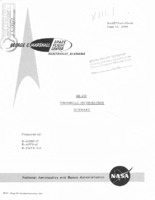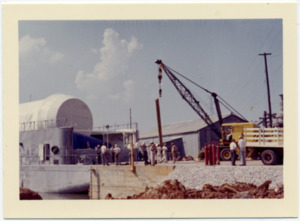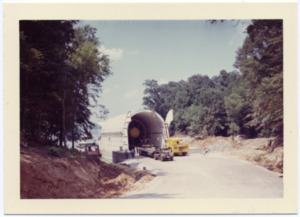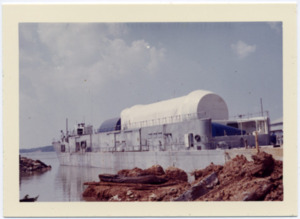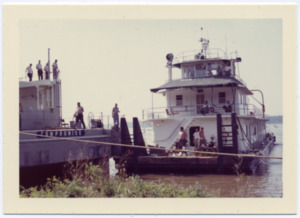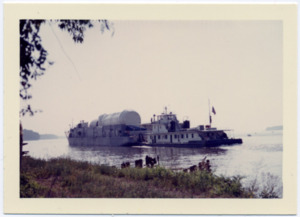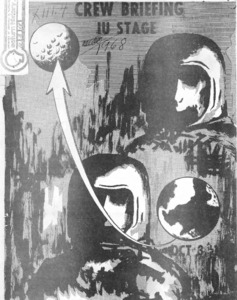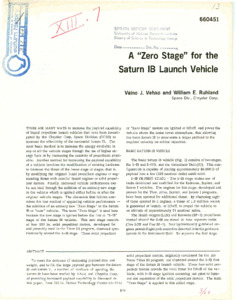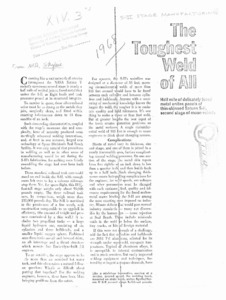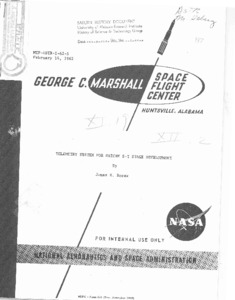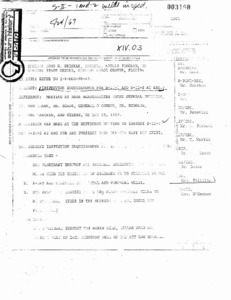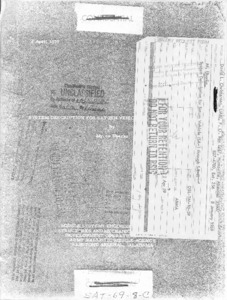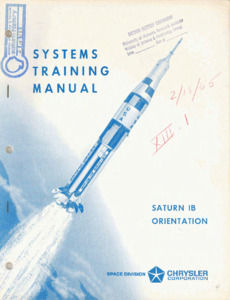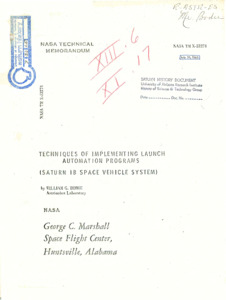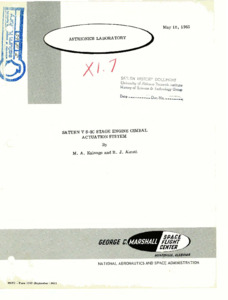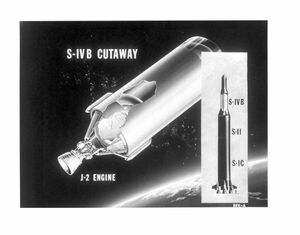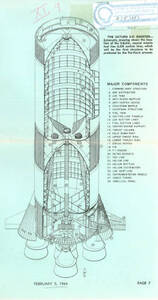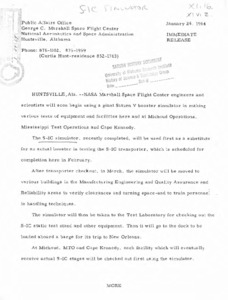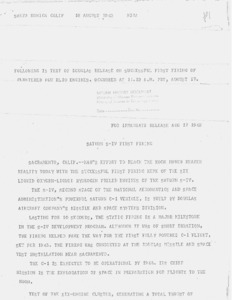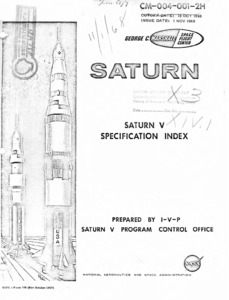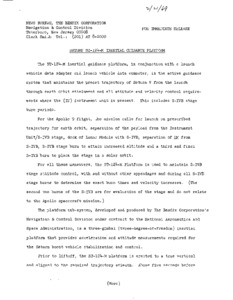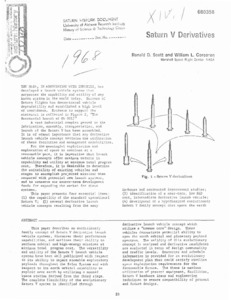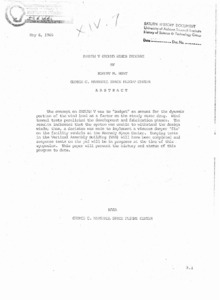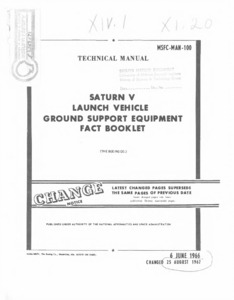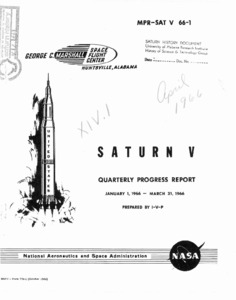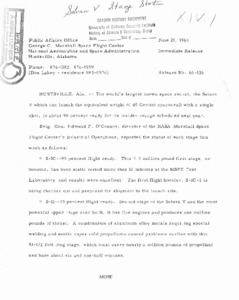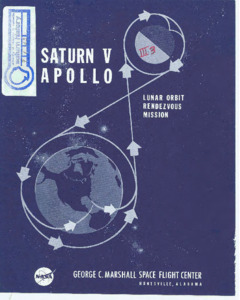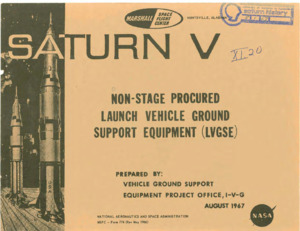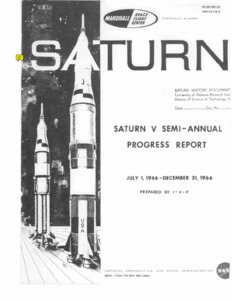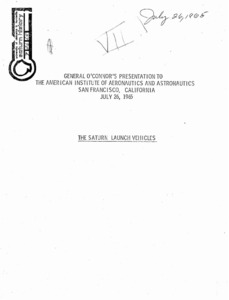
Browse Items (175 total)
Sort by:
-
"AS-203 Technical Information Summary."
"This report outlines, through a series of sketches with accompanying text, the general features of the SA-203 Launch Vehicle and information on launch preparation, the launch facility and mission peculiar experiments." -
A Saturn rocket stage is loaded onto a barge on the Tennessee River.
The stage is being transported to the Mississippi Test Facility. -
A Saturn rocket stage is loaded onto a barge on the Tennessee River.
The stage is being transported to the Mississippi Test Facility. -
A Saturn rocket stage is loaded onto a barge on the Tennessee River.
The stage is being transported to the Mississippi Test Facility. -
A Saturn rocket stage is loaded onto a barge on the Tennessee River.
The stage is being transported to the Mississippi Test Facility. -
A Saturn rocket stage is loaded onto a barge on the Tennessee River.
The stage is being transported to the Mississippi Test Facility. -
"Crew Briefing : Instrument Unit Stage Presentation".
Document outlining different slides of a presentation containing numerous organizational charts, diagrams and bullet-list points. -
"Vibration and acoustic environment characteristics of the Saturn V launch vehicle."
This paper presents representative examples of vibration and acoustic data from flights of the Saturn V launch vehicle and static firings of Saturn V launch vehicle stages. The purpose of the paper is to provide vibration and acoustic environment characteristics which are pertinent to the design of launch vehicles -
"A 'Zero Stage' for the Saturn IB Launch Vehicle."
To meet the demands of increasing payload size and weight, and to fill the large payload gap between the Saturn IB and Saturn V, a number of methods of uprating the Saturn IB have been studied by NASA and Chrysler Corp. of providing increased payload capability is discussed in this paper. Four 120 in. United Technology Center UA-1205 solid propellant motors, originally developed for the Air Force Titan III program, are clustered around the S-IB first stage of the Saturn IB launch vehicle. These four solid propellant motors provide the total thrust for liftoff of the vehicle, with S-IB stage ignition occurring just prior to burn-out and separation of the solid propellant motors. The term "Zero Stage" is applied to this added stage. -
"The toughest weld of all" S-II stage manufacturing.
Article explores the outer layer of the Saturn S-II along side its benefits and complications. Contains poorly rendered images displaying the process. -
"Telemetry system for Saturn S-I stage development."
The telemetry system used on the Saturn S-I stage for the transmission of vehicle test data is described. Multiplex and modulationtechniques such as PAM/FM/FM, SS/FM and PGM are used in the system. The diverse data requirements for developing the eight-engineliquid-fueled stage necessitated the use of a combination of severalmodulation techniques to efficiently handle the data. A cursory comparisonis made of the merits of each technique. Physical and electricalrequirements and characteristics of the system are outlined. -
"Telegraphic message : inspection requirements for S-II-1 and S-II-2 at KSC."
Photocopy of an inspection list requirements for S-II-1 and S-II-2. -
"System description for Saturn vehicle (SA-1 through SA-4)."
Missing pages iv, 3, 6 to 8. Photocopy of files containing sections of the project. -
"Saturn IB orientation training manuel."
Prepared through joint efforts of Personnel Department, Education and Development Branch, Systems Training Unit, Michoud Operations and Engineering Communications Department, Technical Information Branch, Applied Communications Engineering Section, Huntsville Operations.; This publication presents a brief descriptive summary of the Saturn IB vehicle and Chrysler's Corporation's accomplishments in the missiles and space field. The Saturn IB information presented herein is based on current plans for each of the stages. Although there may be design changes from vehicle to vehicle, the basic components, systems, and operating principles will remain similar to previous models. -
"Techniques of implementing launch automation programs" (Saturn IB space vehicle system).
This paper identifies the methods and equipment through which automation is becoming a major factor in testing and launching Saturn IB space vehicles. The merits of a digital guidance computer and its impact in extending automated checkout are stressed; also a logical basis is established for computer and manual test control. Hardware and software elements of the automated system are described, and details pertaining to reliability are emphasized. A concluding appraisal suggests that automation will play an expanding role in future test and launch operations. -
"Space flight projects - today and tomorrow."
NASA symposium on scientific and technical Information. -
"The significance of parameters affecting the heat transfer to the liquid hydrogen in the Saturn S-IVB stage for the lunar orbit rendezvous mission."
The Saturn S-IVB stage has a requirement for orbiting around the earth for up to 4.5 hours with approximately 60 percent of its initial propellant remaining at the end of the coast (prior to restart) . Extensive analyses must be performed to insure that this requirement is met. Both the maximum and minimum heat transfer rates are important because the maximum rates affect the hydrogen boiloff losses and thus the initial propellant loading requirements. The minimum rates are important because the boil off gases are used to maintain a minimum axial thrust level by venting the gases continuously through aft facing nozzles. This provides for a settling of the propellant throughout the orbital coast and alleviates the need for periodically venting the tank under zero gravity. -
"Saturn V S-IC stage engine gimbal actuation system."
The actuation system for the Saturn V S-IC stage is described and compared to the Saturn I system. The use of mechanical feedback actuators that result in a significant increase in system reliability and the damping of load resonance is discussed. The unprecedented component sizes and system requirements are cited. -
"S-II Engine."
8 x 10 inch black and white diagram of the Saturn II engines. -
S-IVB cutaway and J-2 engine."
8 x 10 inch black and white diagram of the JII engine and the Saturn IV. -
"S-IC Saturn booster."
8 x 10 inch black and white diagram of the Saturn booster engines. -
Press Release : S-IC simulator--Immediate release.
Huntsville, Ala. -- NASA Marshall Space Flight Center engineers and scientists will soon begin using a giant Saturn V booster simulator in making various tests of equipment and facilities here and at Michoud Operations, Mississippi Test Operations and Cape Kennedy. -
"Saturn V S-IC stage engine gimbal actuation system."
The actuation system for the Saturn V S-IC stage is described and compared to the Saturn I system. The use of mechanical feedback actuators that result in a significant increase in system reliability and the damping of load resonance is discussed. The unprecedented component sizes and system requirements are cited. -
"Saturn S-IV first firing."
Press release detailing the firing of the Saturn S-IV in California. -
"Saturn V specification index."
The purpose of the'saturn V Specification Index is to provide the official detailed record of all specifications and specification changes required for configuration management of the Saturn V Program and to report specification submittal and approval status. -
"Saturn ST-124-M inertial guidance platform."
a press release which focuses around the Apollo 9 flight and what role the ST-124-M inertial guidance platform has in it. -
"Saturn V derivatives."
This paper desciibes an evolutionary family concept of !h turn V derivative launch vehicle systems, discusses their performance capabilities, and outlines their ability to perform orbital and hlgh-energy missions at minimum total program cost. -
"Saturn V first stage annual progress report : fiscal year 1966."
This report is the consolidation of D5-11994, "Quarterly Technical Progress Report," for the fourth fiscal quarter and the fiscal year 1966 Annual Progress Report and places special emphasis on activities on the fourth fiscal quarter. -
"Saturn V ground winds program."
The concept on Saturn V was to "budget" an amount for the dynamic portion of the wind load as a factor on the steady state drag. Wind tunnel tests paralleled the development and fabrication phases. The results indicated that the system was unable to withstand the design winds; thus, a decision was made to implement a viscous damper "fix" on the facility vehicle at the Kennedy Space Center. Damping tests in the Vertical Assembly Building (VAB) will have been completed and response tests on the pad will be in progress at the time of this symposium. This paper will present the history and status of this program to date. -
"Saturn V launch vehicle ground support equipment fact booklet."
This booklet has been prepared to provide a quick reference to Saturn V stage peculiar ground support equipment. It consists of visual presentations and a brief description of each major component. It is intended to quickly familiarize concerned elements with the over-all MSFC launch vehicle ground support equipment and is not intended for design usage. The booklet has been prepared in five sections. Section I contains the introductory material and a description of the Saturn V mobile launcher (ML). Section II contains information on the umbilical equipment. Section III contains information on the servicing equipment, both fixed and mobile. Section IV contains information on the access equipment. Section V contains information on the handling and auxiliary equipment. -
"Saturn V quarterly progress report : January - March."
Quarterly progress report for the months of January - March, 1966. -
"Saturn V specification cross reference index."
The purpose of the Saturn V Specification Cross Reference Index is to Supplement CM-004-001-2H, the Saturn V Specification Index. It is intended to provide a convenient means of finding the specifications by specification number which is cross referenced to Specification Matrix Number and contract end item number. More complete information on specifications including preparation, approval, and contractual status as well as all effective Specification Change Notices (SCN's) can be obtained from CM-004-001-2H, the Saturn V Specification Index which contains the master listing of the same specifications arranged in logical management and functional groupings and listed in Specification Matrix number order. More complete information on hardware can be obtained from various Saturn V Configuration Accounting Indices which list items by in contract end item (CEI) number order.; This document supplements the Saturn V specification index CM -004-001-2H of the same issued date. -
"Saturn V stage progress."
Report detailing the progress of the Saturn V's construction, focusing on the individual parts. -
"Saturn V America's moon rocket."
Diagram that displays the Saturn V rocket with a page beneath detailing the function of each stage. -
"Saturn V Apollo flight configuration."
Diagram displaying the internal rooms, pieces and functions of the Saturn V as well as the space-suits of the astronauts. -
"Saturn V Apollo lunar orbit rendezvous mission."
Diagram explaining the process of a lunar mission from liftoff to recovery. -
"Saturn V : non-stage procured launch vehicle ground support equipment."
The functions, authority, management relationships, and responsibilities of the Launch Vehicle Ground Support Equipment Project Office are described. Functions and examples of non-stage procured Launch Vehicle Ground Support Equipment (LVGSE) are described and illustrated. -
"Saturn V inboard profile : Launch escape system flight separation."
Diagram displaying the launch escape system flight separation in progress. -
"Saturn V semi-annual progress report July-December, 1966."
MA-001-00202H.; MPR-SAT V 66-3.; ABSTRACT: This Saturn V Semi-Annual Progress report describes progress and major achievements from July 1, 1966, through December 31, 1966, in the Saturn V Program. -
"The Saturn launch vehicles."
General O'Connor's presentation to the American Institute of Aeronautics and Astronautics. Centers around saturn space vehicles and makes references to slides.
